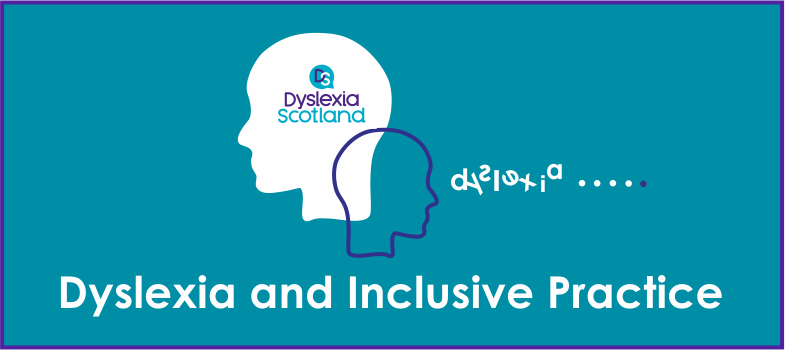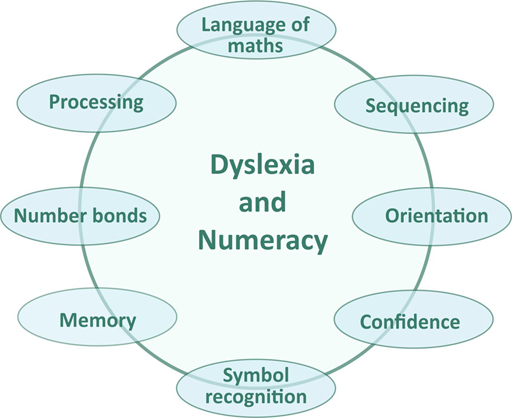2.4. Numeracy development and the identification of dyslexia
The Numeracy Across Learning Principles and Practice Paper states the following:
All schools, working with their partners, need to have strategies to ensure that all children and young people develop high levels of numeracy skills through their learning across the curriculum. These strategies will be built upon a shared understanding amongst staff of how children and young people progress in numeracy and of good learning and teaching in numeracy. Collaborative working with colleagues within their own early years setting, school, youth work setting or college and across sectors will support staff in identifying opportunities to develop and reinforce numeracy skills within their own teaching activities.
Being numerate helps us to function responsibly in everyday life and contribute effectively to society. It increases our opportunities within the world of work and establishes foundations which can be built upon through lifelong learning. Numeracy is not only a subset of mathematics; it is also a life skill which permeates and supports all areas of learning, allowing young people access to the wider curriculum. We are numerate if we have developed the confidence and competence in using numbers which will allow individuals to solve problems, analyse information and make informed decisions based on calculations. A numerate person will have acquired and developed fundamental skills and be able to carry out number processes but, beyond this, being numerate also allows us to access and interpret information, identify possibilities, weigh up different options and decide on which option is most appropriate. Numeracy is a skill for life, learning and work. Having well-developed numeracy skills allows young people to be more confident in social settings and enhances enjoyment in a large number of leisure activities. For these and many other reasons, all teachers have important parts to play in enhancing the numeracy skills of all children and young people. Numerate people rely on the accumulation of knowledge, concepts and skills they have developed, and continually revisit and add to these. All practitioners, as they make use of the statements of experiences and outcomes to plan learning, will ensure that the numeracy skills developed from early levels and beyond are revisited and refreshed throughout schooling and into lifelong learning.
Download the Numeracy across Learning Principles and Practice Paper [Tip: hold Ctrl and click a link to open it in a new tab. (Hide tip)] .
Dyslexia and difficulties with numeracy and maths
Module 2 explained that the associated characteristics within the Scottish working definition can have an impact on some learners and their ability to develop their numeracy and math skills.
Download Dyslexia Scotland’s information leaflet on Ideas for Supporting Maths
Learners with numeracy difficulties may:
- Struggle with the basic concept of numbers, e.g., recognising a group of four counters as "four" or equate the numeral ‘4’ with four concrete objects
- Have difficulty with fundamental mathematical concepts, e.g., addition, subtraction, multiplication and division
- Have limited skills in estimation tasks or be able to sense whether their answer is correct or approximately correct
- Have no devised strategies to compensate for lack of recall
- Find it hard to lay out their work neatly, resulting in mistakes, e.g., in adding up a column of numbers
- Struggle with mental arithmetic, possibly as a result of short-term and working memory issues
- Display high levels of maths anxiety and deploy avoidance tactics
Dyscalculia definition
In Scotland there is no formal definition for dyscalculia and the recommendation would be to follow the same principles and practice as the dyslexia identification pathway using a collaborative process.
Download Dyslexia Scotland’s leaflet on Dyscalculia
Consider the definitions below:
British Dyslexia Association
Dyscalculia is usually perceived of as a specific learning difficulty for mathematics, or, more appropriately, arithmetic. Currently (January 2015) a search for ‘dyscalculia’ on the Department for Education’s website gives 0 results as compared to 44 for dyslexia, so the definition below comes from the American Psychiatric Association (2013):
“Developmental Dyscalculia (DD) is a specific learning disorder that is characterised by impairments in learning basic arithmetic facts, processing numerical magnitude and performing accurate and fluent calculations. These difficulties must be quantifiably below what is expected for an individual’s chronological age, and must not be caused by poor educational or daily activities or by intellectual impairments”.
The BDA are of the view that because definitions and diagnoses of dyscalculia are in their infancy and sometimes contradictory, it is difficult to suggest a prevalence, but research suggests it is around 5%. However, ‘mathematical learning difficulties’ are certainly not in their infancy and are very prevalent and often devastating in their impact on schooling, further and higher education and jobs. Prevalence in the UK is at least 25%.
Developmental Dyscalculia often occurs in association with other developmental disorders such as dyslexia or ADHD/ADD. Co-occurrence of learning disorders appears to be the rule rather than the exception. Co-occurrence is generally assumed to be a consequence of risk factors that are shared between disorders, for example, working memory. However, it should not be assumed that all dyslexics have problems with mathematics, although the percentage may be very high, or that all dyscalculics have problems with reading and writing. This latter rate of co-occurrence may well be a much lower percentage.
Because mathematics is very developmental, any insecurity or uncertainty in early topics will impact on later topics, hence to need to take intervention back to basics.
Recent research has identified the heterogeneous nature of mathematical learning difficulties and dyscalculia, hence it is difficult to identify via a single diagnostic test. Diagnosis and assessment should use a range of measures, and test protocol, to identify which factors are creating problems for the learner. Although on-line tests can be of help, understanding the difficulties will be better achieved by an individual person-to-person diagnostic, clinical interview.
This view supports the current methodology and collaborative identification process in Scotland.
Department for Education and Skills (DfES) England
Dyscalculia is a condition that affects the ability to acquire arithmetical skills. Dyscalculic learners may have difficulty understanding simple number concepts, lack an intuitive grasp of numbers, and have problems learning number facts and procedures. Even if they produce a correct answer or use a correct method, they may do so mechanically and without confidence.
Very little is known about the prevalence of dyscalculia, its causes, or treatment. Purely dyscalculic learners who have difficulties only with number will have cognitive and language abilities in the normal range, and may excel in nonmathematical subjects. It is more likely that difficulties with numeracy accompany the language difficulties of dyslexia.
Activity 8
- Look at your school/local authorities’ policies for numeracy and math
- Does the policy make a clear connection with dyscalculia or numeracy difficulties?
- In your view can this be improved to support learners and staff and if so how?
Use your Reflective Log to note your thoughts and findings.
Action Plan
- Use your Action Plan to identify next steps you will take, who you will discuss this with and how the impact can be evaluated
2.3. Language development and identification of dyslexia

